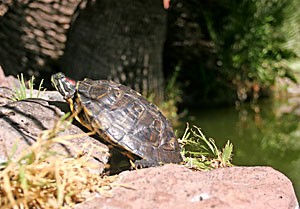Two small koi ponds nestled among the palms at the corner of North Park Avenue and East Second Street are within stone walls – intended to keep out stray cattle and horses – that line the boundaries of the original campus.
Goldfish prowl the green pools daily, while turtles lazily surface for students who stop and contemplate from the nearby benches between classes.
Chelsea Cady, a philosophy junior, said this well-hidden and odd feature is her favorite part of campus.
“”I just found out about them the other day,”” said Cady. “”It’s like, ‘Oh, wow, what a nice surprise.'””
Campus surprises are not limited to the koi ponds.
The pathway that ends between the Marley and Shantz buildings offers a collision of new and old design, along with a blanket of ivy on the Forbes building.
“”It’s like you’re walking in a movie set,”” said Danielle DeSorda, an international studies sophomore. “”It’s exactly how I imagined a big university should look.””
Despite the potential for architectural train wrecks, the consistent use of one particular material lends continuity to the facilities.
“”I love how it’s all red brick,”” said DeSorda. “”It really ties the whole campus together.””
As times change and the UA looks to minimize its environmental impact, new building materials are changing the face of recent installations.
The Meinel Optical Sciences building is the latest showpiece on the UA campus, having won several architectural awards upon its completion this spring, according to the Facilities Design and Construction Web site.
The Meinel building utilizes copper panels – a mineral that has exerted much influence on Arizona’s history – to deflect heat and minimize cooling costs, while still within the visual character of other buildings.
Across the UA Mall, the Stevie Eller Dance Theatre uses rusted mesh panels on its east face to suggest movement while retaining the trademark UA red. A similar technique is used on the new Chemical Sciences building, behind the Koffler building.
The UA has a strong presence in space sciences, collaborating with NASA on nearly every mission in the past few years.
This strength is reflected by the presence of two observatories. The Steward Observatory – listed on the National Register of Historic Places – was dedicated in 1923, while the newer Flandrau Observatory is open for public viewing most nights of the year, with a large moon rock featured on its front lawn.
Artistic endeavor also plays into the UA’s campus, with numerous pieces on prominent display.
Michael Valdez, a computer science junior, said he appreciates the bronze statue of an American Indian woman in front of the UA Museum of Art.
Valdez, whose wife is Navajo, said the figure appears to be praying alone, which is unusual in such cultures.
“”I thought it was really unique,”” said Valdez.
The “”25 Scientists”” arch in front of the Koffler building was designed with UA researchers’ input on the individual figures.
“”Glyph,”” located behind the Student Union Memorial Center, is a stainless steel tribute to American Indian petroglyphs seated among a backdrop of Saguaro cactuses – an inadvertent nod to the UA’s original colors of sage and silver.
Nearby, centered in the cul-de-sac where North Mountain Avenue ends, is a giant wind chime made of dog tags representing those who were killed on the USS Arizona during the attack on Pearl Harbor.
Even less interpretation is necessary in front of McKale Center, where a bust of John “”Button”” Salmon – the originator of UA’s “”Bear Down”” fight slogan – is posted.
Nature places its own signature all across the UA campus, creating a massive garden in the Sonoran Desert.
More than 400 species of plants from all over the world are located on UA’s grounds, and many are the largest examples of their species in Arizona, said Elizabeth Davidson, director of the UA arboretum.
“”Some of those species were brought to campus by UA’s early faculty, so the UA might be the origin of many private specimens,”” said Davidson.
Davidson said among her favorites are a floss silk tree near the south side of the Engineering building, which will be flowering during Family Weekend, and a baobab tree next to the Administration building.
A native of Madagascar, that tree is the largest and oldest of its kind in the Western Hemisphere, said Davidson.
“”As an arboretum, we’re very highly rated,”” said Davidson. “”We’re lucky that we can enjoy it right here on campus.””









